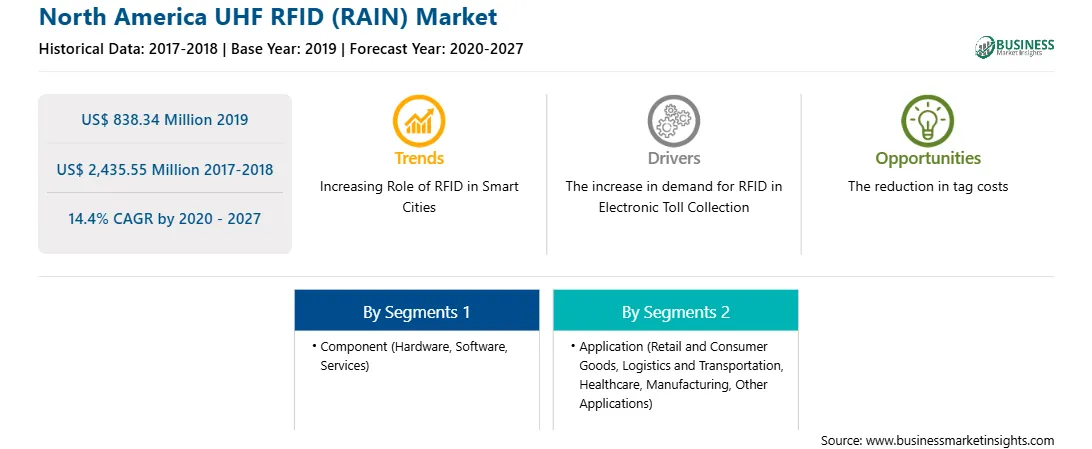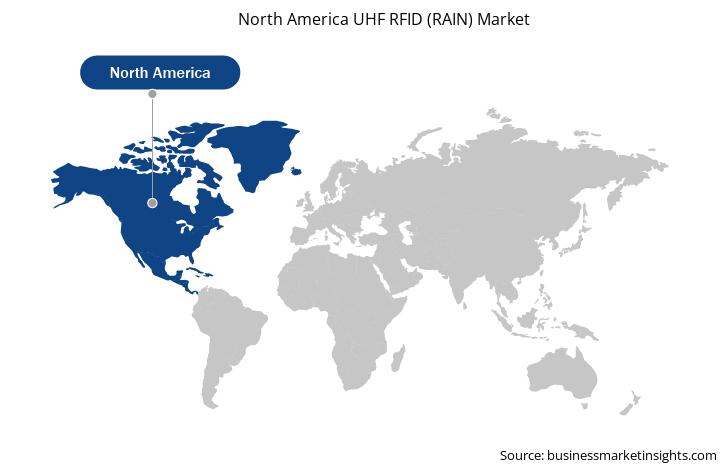The ultrahigh-frequency (UHF) bands are operational over the frequency range of 300 MHz - 1 GHz. Radio frequency identification (RFID) systems that operate in the UHF frequency spectrum, are termed UHF RFID systems. The term RAIN originates from radio frequency Identification, which acts as a nod to the link between UHF RFID and the cloud. Several hardware components such as tags and readers are integrated within this technology. The RFID tags are used to track all types of objects in the retail, healthcare, and manufacturing industries, among others, and it also allows them to manage assets and inventory. The UHF RFID tags/readers functions at 433 MHz and 860–960 MHz The tags operate with the help of the far-field radiative coupling principle or backscatter coupling principle. It has a larger read range than low-frequency (LF) and high-frequency (HF) tags. Due to high data transfer, the UHF RFID tags are suitable for applications that require reading several items at once. The UHF RFID tags consist of antenna and integrated circuits (ICs); the antenna is used to receive RF waves, and the IC includes processing information, four memory banks, send and receive information, and anti-collision protocols. The North America UHF RFID (RAIN) market is likely to grow at substantial pace due to a surge in the retail sector, as the technology is hugely adopted for apparel tagging; the market has witnessed swift growth in the past few years. The retail sector usually adopts passive UHF RFID tags operating at the 860–960 MHZ frequency band; the exact frequencies over which the tags are operated depend upon the country. However, these tags cannot be read effectively when attached to objects containing water and animal tissues as the water absorbs UHF waves. The technology also does not work well with metals as the tags get detuned while attached to metal objects. Thus, the disability of UHF RFID systems to perform in the proximity of water and metal hinders the market growth. Also, rising usage of RFID technologies in retail sector is a major factor driving the North America UHF RFID (RAIN) market.
North America has the highest adoption and growth rate of new technologies owing to favorable government policies to boost innovation and strengthen the infrastructure capabilities. Hence, any impact on industries is expected to affect the economic growth of the region in a negative manner. The US is one of the prominent markets for UHF RFID (RAIN) due to the growing retail and e-commerce, and healthcare sectors. The huge increase in the number of confirmed cases and rising reported deaths has affected these industries. The factory and business shutdowns across the US, Canada, and Mexico impact the adoption of the UHF RFID (RAIN). The retail sector has faced considerable shifts, consumer spending on groceries continue to increase. However, spending on apparel and other accessories decreased substantially in 2020. Moreover, in the mid-2020, the retail and e-commerce sales have increased gradually, leads to slight growth in the market in North America. RFID technology is also highly used in the healthcare industry to track their assets. To combat the virus, the region has started shipping vaccines and PPE kits within the region where RFID technology has made a comeback to track and authenticate test kits, PPE, and vaccines. Thus, this also leads to slight growth in the market. COVID-19 has had a severe impact on transportation and automotive, and trade activity. North America is home to many manufacturing and technology companies. Thus, the coronavirus outbreak's impact was quite severe in 2020 and likely in 2021. The negative impact of COVID-19 is short-term; it is likely to decrease in the coming years.

Strategic insights for the North America UHF RFID (RAIN) provides data-driven analysis of the industry landscape, including current trends, key players, and regional nuances. These insights offer actionable recommendations, enabling readers to differentiate themselves from competitors by identifying untapped segments or developing unique value propositions. Leveraging data analytics, these insights help industry players anticipate the market shifts, whether investors, manufacturers, or other stakeholders. A future-oriented perspective is essential, helping stakeholders anticipate market shifts and position themselves for long-term success in this dynamic region. Ultimately, effective strategic insights empower readers to make informed decisions that drive profitability and achieve their business objectives within the market.

| Report Attribute | Details |
|---|---|
| Market size in 2019 | US$ 838.34 Million |
| Market Size by 2027 | US$ 2,435.55 Million |
| Global CAGR (2020 - 2027) | 14.4% |
| Historical Data | 2017-2018 |
| Forecast period | 2020-2027 |
| Segments Covered |
By Component
|
| Regions and Countries Covered | North America
|
| Market leaders and key company profiles |
The geographic scope of the North America UHF RFID (RAIN) refers to the specific areas in which a business operates and competes. Understanding local distinctions, such as diverse consumer preferences (e.g., demand for specific plug types or battery backup durations), varying economic conditions, and regulatory environments, is crucial for tailoring strategies to specific markets. Businesses can expand their reach by identifying underserved areas or adapting their offerings to meet local demands. A clear market focus allows for more effective resource allocation, targeted marketing campaigns, and better positioning against local competitors, ultimately driving growth in those targeted areas.

The UHF RFID (RAIN) market in North America is expected to grow from US$ 838.34 million in 2019 to US$ 2,435.55 million by 2027; it is estimated to grow at a CAGR of 14.4% from 2020 to 2027. The adoption of smart devices and mounting government investments—especially in countries such as—US and Canada focused on the R&D and installations of Internet of Things (IoT) in the manufacturing, utilities, retail, and other sectors is fueling the growth of IoT. It confers various objects with the ability to interconnect and share data. IoT applications necessitate a data connection between the physical and digital world, and UHF RFID is the finest technology to bridge these spaces. With the boom in IoT in various countries, most networked objects would be connected wirelessly through the passive UHF RFID technology that seamlessly allows passive objects to communicate crucial data, which can be used to identify these objects with exact place and time details. The technology adds intelligence to the IoT ecosystem and simplifies new applications for connected resources.
The North America UHF RFID (RAIN) market is segmented into component, and application. Based on component, the market is segmented into hardware and software and services. The hardware segment held the largest share of North America UHF RFID (RAIN) market in 2019. The UHF RFID (RAIN) market, based on application, is segmented into retail and consumer goods, logistics and transportation, healthcare, manufacturing, and other applications. The market for the retail and consumer goods segment held the largest share of North America UHF RFID (RAIN) market in 2019.
A few major primary and secondary sources referred to for preparing this report on the UHF RFID (RAIN) market in North America are company websites, annual reports, financial reports, national government documents, and statistical database, among others. Major companies listed in the report are CAEN RFID S.r.l; Convergence Systems Limited; Impinj, Inc.; Invengo Technology Pte. Ltd.; Jadak- A Novanta Company; Lowry Solutions Inc.; Murata Manufacturing Co., Ltd.; NXP Semiconductors N.V.
The List of Companies - North America UHF RFID (RAIN) Market
The North America UHF RFID (RAIN) Market is valued at US$ 838.34 Million in 2019, it is projected to reach US$ 2,435.55 Million by 2027.
As per our report North America UHF RFID (RAIN) Market, the market size is valued at US$ 838.34 Million in 2019, projecting it to reach US$ 2,435.55 Million by 2027. This translates to a CAGR of approximately 14.4% during the forecast period.
The North America UHF RFID (RAIN) Market report typically cover these key segments-
The historic period, base year, and forecast period can vary slightly depending on the specific market research report. However, for the North America UHF RFID (RAIN) Market report:
The North America UHF RFID (RAIN) Market is populated by several key players, each contributing to its growth and innovation. Some of the major players include:
The North America UHF RFID (RAIN) Market report is valuable for diverse stakeholders, including:
Essentially, anyone involved in or considering involvement in the North America UHF RFID (RAIN) Market value chain can benefit from the information contained in a comprehensive market report.